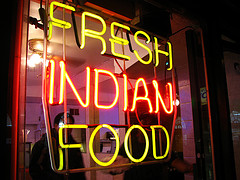Whenever I walk somewhere, and someone hands me a flyer, it’s like they’re telling me, “Here, you go throw this away.”
-Mitch Hedberg
If you’ve ever walked down a street in midtown Manhattan, you’ve most likely been in the uncomfortable position of being handed a flyer for a restaurant, club, event, whathaveyou. It never struck me before, but this is a great example of Value Exchange Dissonance.
Value Exchange Dissonance is something I just made up. It describes a situation in which one party takes an action that they believe provides enough value to prompt an action by another party, when the other party feels it is an imposition on them (negative value).
When a person hired by a restaurant hands you a flyer, here’s what their perception of the exchange is:
“Greetings, random person in the neighborhood! Here is a free menu with information on all the wonderful things you can eat at my establishment. Now, come and have a meal at my restaurant. It’s the least you can do, after I provided you with this information!”
Taking our knee-jerk social marketer hats off for a moment, let’s now look at the experience from the point of view of the person receiving the flyer.
“Here I am just going about my day, on my way somewhere, and some random person thrusts a piece of paper at me, disrupting my personal space, my rhythm, distracting me from whatever I’ve been thinking about and pushing their message at me without regard for my interest or where my attention was. If I was hungry, I’d go to a restaurant that didn’t need to disrupt my day. I don’t even like Indian food! Screw this place.”
Value Exchange Dissonance. To the extreme. And the end result is the opposite of what was intended.
There is a crucial point there. A marketing engagement is valuable or not valuable based on the POV of the ‘receiver’ of the engagement.
In this case, if 0 is the baseline, handing someone a flyer may have a +3 perceived value for the restaurant, but if its a -6 to the recipient, it still nets out at -3.
This is why User Experience is so important. There are lots of examples of otherwise well-meaning people and organizations who may genuinely not be paying attention to how the experience plays out for the other side.
Are you paying attention to how you may create or destroy value in an experience? Or are you another victim of Value Exchange Dissonance?







Thank you, Jeremy, for saying what I’ve felt for years: Hand me that, and I’ll throw it away. It’s just more garbage. And yes, I’m trying to enjoy my life, not have to deal with being interrupted.
Although, between growing up in Chicago and serving in the Navy, where we had to deal with hawkers in our face at every port, I’ve become fairly adept at totally ignoring these guys and pretending they don’t exist.
What Tac said is true. However, Rebecca, I’m not disparaging the entire paper flyer business. As a former DJ, I found the use of flyers advertising club nights that I spun at to be pretty effective (of course, this was pre-Facebook/Twitter).
HOWEVER, I was able to target the flyers to people who’d be most interested in the events by putting them at the door of similar venues, and handing them out outside nights with similar music. This is not the same as “well, this person is walking down the street, they must want to know about my diner!”
It’s telling, also, that when this stuff happens to us in the digital sphere, we almost always say “no.” There are spam filters and Facebook flags to keep this stuff away from us. IRL marketing should take note.
I think this is exactly what Godin gets at with permission marketing – instead of having something unwelcome thrust on you, you’re saying, “Yes, I’m open to offers and information about products I might like,” which for marketers is a situation that generates a higher conversion rate.
Great post. I’m consistently impressed with your blog.
The problem is that this is CPM (Cost Per Thousand) mentality. Yes for you and your husband this is great. In fact, if it were only marginally beneficial for the restaurant the better it is for you because the more copies your husband needs to make to return the same level of benefit.
But a more effective, or to use Jeremy’s terms, Value Exchange Harmony (?) why not just target those people who want the menu/coupon/ad? Oh yeah, because print doesn’t do that. But mobile, location based apps do.
So enjoy your rent and fat babies while you can because soon the dissonance will be too great and the restaurants will switch to more targeted, effective and harmonious tactics.
From the wife of a printer who makes his income from flyers, I’m apt to disagree. Its actually made me rethink them as effective marketing tools and I’ve started taking them and thanking those hired to distribute them. You’d be surprised how much business is done through them. I’ve found some good deals that way. I think its the negative/confrontational NYer in us that sees this as an invasion of sorts – not everyone feels this way. There is an art & a voice that goes behind these small pieces of thick paper being “thrust” into your hands. And they pay my rent, feed my baby & allow me to meet friends for food & drinks.
BUT…the more you throw away, the more the company/restaurant has to buy and therefore the more business in reorders come to my husband. Throw on!